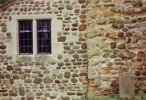 Stanton on the Wolds Stanton on the Wolds
All Saints
Stonework
The fabric of this small church reveals a chequered history of dereliction
and restoration. Viewed from the south, the style of the stonework indicates
that the original building was built in three parts with the earliest at the
east end. The mixture of stones and later repairs possibly suggest that the
surface used to be rendered.
The wall fabric contains a variety of local building stones. Brown pebbles/boulders
of rounded off sandstones, probably were collected in the fields from the boulder
clay, carried some distance by glacial/alluvial drift. Orange, crumbling ironstones
(Marlstone) are from the Lias, with some stones containing fossils. The Marlstone
probably came from beds in the Vale of Belvoir, such as those at Holwell and
Upper Broughton. The grey/white flat stones are local, Lower Jurassic, Lias
limestone dug out of the bedrock. Inserts include Carboniferous sandstones
from the South Derbyshire Coal Measures.
The buttresses are probably Bulwell Golden Stone, a dolomitic or magnesium
limestone produced by quarries originally at Bulwell and now at Linby, Notts.
The buttress, where the two parts of the chancel join, is keyed-in with a few
blocks of Middle Jurassic, Lincolnshire oolitic limestone, which is still quarried
at Ancaster and Stamford. The quoins at the south-west corner are sawn blocks
of Lincolnshire Limestone, from the major restoration by Harriet Robertson
in 1888/9.
The base of the bellcot tower at the west-end is a mixture of handdressed
stones including Triassic sandstones probably from the Castle Donington area;
Permian magnesium limestone, known as Mansfield White Stone (distinguished
by green clay seams); and ironstones. The top of the tower is also Triassic
sandstone. Mansfield White is the stone used in Southwell Minster and at the
Houses of Parliament.
The north wall appears to replace an earlier collapse. It is built of rubble
stones, pebbles and pieces of Lias. Relatively good free stone (Triassic sandstone
and ironstone) is used around windows and for quoins. The eastern buttress
is Lincolnshire Limestone. The east wall is also rubble stone. The northern
buttress is Bulwell Stone keyed-in with Lincolnshire Limestone blocks.
The vestry at the north-west corner was built in 1977
of local pebbles from the fields. They were collected by local farmers with
help from the Sunday School children.
| 




